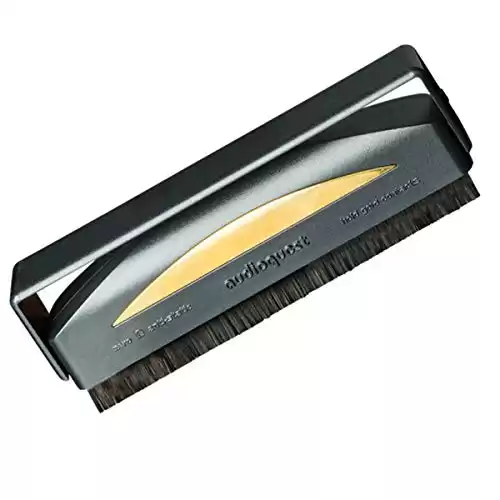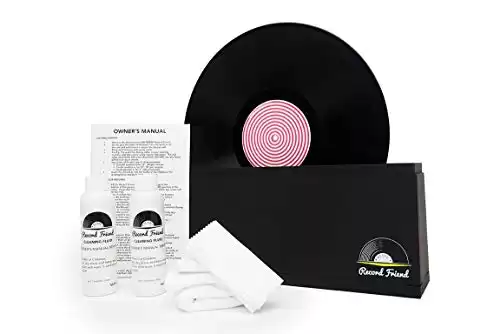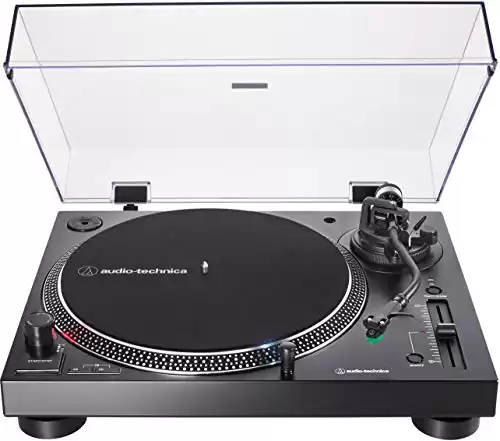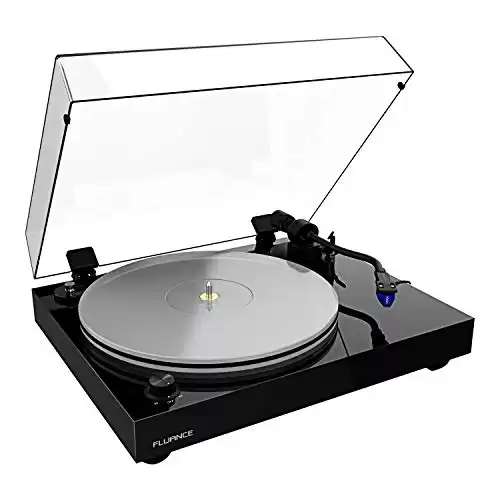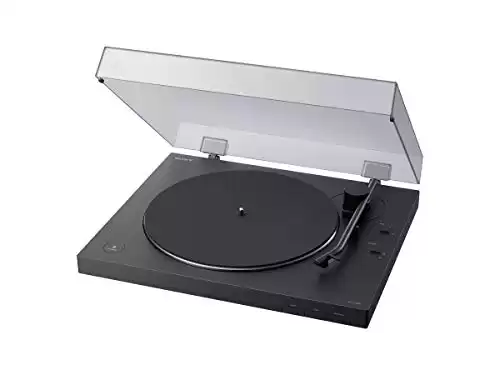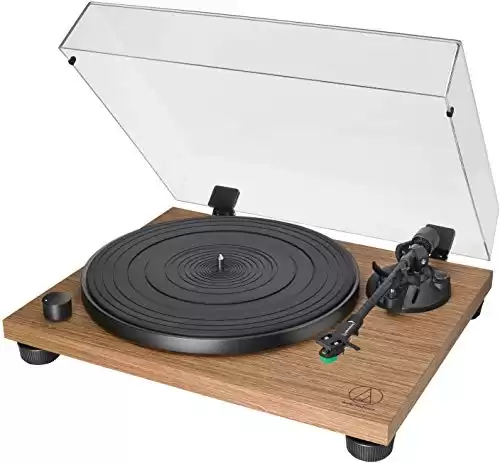Vinyl records are a fun way to embrace the music industry’s past. When you listen to jazz, rock ‘n roll from its early era, or even modern grunge on this medium, the unique tones sound better on a turntable than through CDs or online streaming.
One of the issues you can encounter when listening to records on a turntable is a popping sound. Although it may be part of the audio recording, it is usually associated with some dust in the grooves.
This issue may also indicate that your needle requires replacement.
Why Does My Record Have a Popping Sound?
Turntables produce popping sounds, crackling, and minor distortion, even when playing new records. This issue may involve a faulty audio recording, dust in the equipment, a malfunctioning needle, or a dirty LP. Cleaning your equipment should help.
Another issue that can adversely impact the sounds coming from your turntable involves static electricity.
If you walk across carpeting to place a record on your player, the discharge may cling to the surface as it plays.
Since a record spins on a turntable, your equipment may generate its own static charge. This issue can cause interference problems.
If you have a new record, debris could get pressed into the grooves. Although you can’t clean this problem to fix it, different phono or needles could disguise the issue if it is bothersome while listening.
The issue could be your turntable if everything with the record gets ruled out. Some speakers are not of a high enough quality to produce an authentic sound.
You typically encounter this issue when purchasing the sub-$100 players that are found online.
However, not all of the affordable record players will create popping sounds, but you will face an increased risk of encountering this problem.
How to Clean a Vinyl Record
Although it may be hard to believe, a vinyl record is more sensitive to scratching than a CD.
You must take great care when cleaning the grooves to prevent degrading the music recorded with this medium.
Since the oil from your hands contributes to the sound degradation process, having a few tools available to take care of this problem will have the music sounding like new again in no time at all.
When cleaning your record, please remember to avoid touching the grooves with your fingers. The fingerprints leave oils, and dust behind that can cause additional popping sounds.
■ Step #1: Remove Static and Dust
A vinyl record brush is your best option when starting to clean your vinyl records. Use long strokes with gentle pressure to remove the unwanted material without causing harm to the surface.
You don’t want to skimp on this tool. Inferior products can inadvertently scratch your vinyl record as bad as toothpaste can ruin a CD.
The best product to use is the AudioQuest Anti-Static Record Brush. It uses conductive carbon fiber bristles with gold contacts to eliminate the debris that causes popping and static.
It also works surprisingly well for cleaning keyboards.
■ Step #2: Inspect the Record
For this step, take your record underneath a soft light to inspect it. Anything blemishes, fingerprints, smudges, and other discoloration problems show up well underneath a standard 60W light bulb.
You don’t want to check for these issues underneath fluorescent lights because the materials won’t be as visible.
If you purchased a used record, you might see numerous issues to correct.
When no blemishes are found, and you’ve followed the first step, the record may be ready to play. If it continues to sound terrible, proceed to the third step.
■ Step #3: Use a Record Cleaning Solution
If you have blemishes on the record, each spot requires a little elbow grease to remove the unwanted materials.
Used records may require having the entire surface getting cleaned with an appropriate solution.
When you start cleaning a vinyl record, take great caution to avoid having any liquid spill on the label. If this problem occurs, it may cause discoloration or force the epoxy to start loosening.
Although several individual bottle solutions are available to take care of this need, Record Friend offers a cleaning kit that is much easier to use. You can spin up to 500 vinyl records clean with this technology.
Once you place the record in the equipment, the machine spins it for you to avoid having more skin oils deposit in the grooves. It uses a dual-wash system that quickly eliminates any external popping sources.
You can purchase additional fluid bottles to work with this investment. If you want pure sounds from your turntable, this cleaning solution delivers consistently excellent results.
■ Step #4: Wipe and Rinse
If you don’t have an automatic cleaning kit available to use, you’ll need to wipe away whatever blemishes and dust remain on the record. It helps to apply pressure using circular hand movements with a microfiber cloth to create a positive result.
You can use a cotton cloth to manage this work, although it will absorb more of the fluid before it picks up the dirt.
Once you’ve given it a good scrubbing, rinse the record in any standard sink. You don’t want the cleaning fluid to stay on the vinyl because it may ruin your 33s, 45s, or 78s.
After the record gets a solid rinse, allow it to dry. If you must handle the vinyl at this stage, do so by using a light grip at the record’s edge or by the label after drying your hands.
■ Step #5: Store Your Records Correctly
After your records go through the cleaning process, you must store the vinyl correctly to avoid having it pick up additional damage.
The best spaces avoid light, humidity, heat, and pressure. Records don’t respond well to stacking, which means you should keep them on shelves with a process similar to books.
Vibrations are less problematic, although they still can impact the structural integrity of the record.
Your vinyl does better in a polyethylene liner instead of a paper one. It’s more expensive, but it also gives you a better long-term storage result.
The Invest in Vinyl brand provides a comprehensive solution that won’t create bleed-through problems that would impact your listening experience as the standard sleeve from the record company can sometimes cause.
Best Vinyl Turntables for Listening to Records
If you love listening to vinyl records, these turntables produce the sound you want at a manageable price.
You’ll avoid most popping issues that originate from the equipment to focus on the pure sounds that come from the needle.
The best vinyl turntables let you listen to records on all three RPM settings: 33, 45, and 78.
Many of them offer digital conversion features so that you can turn the songs into local MP3 files for online listening with the same audio quality as the turntable.
1. Audio-Technica AT-LP120XUSB Turntable
If you love listening to hi-fi music through your stereo equipment, this turntable is the perfect addition to your collection.
It provides entirely manual operations, including dynamic anti-skate control, ensuring that you can avoid almost all of the popping and static sounds that come from cheaper units.
A quartz-speed lock ensures the RPM settings stay true, while the hydraulic tonearm controls provide accurate responses without risking the damage of a manual system.
The Audio-Technica turntable includes a USB cable inside the box for PC and Mac Audacity recording software, although it works with other third-party options.
You get an RCA output cable, AC adapter, and a 45 RPM adapter with a purchase. If you don’t like the dust cover, it comes off quite easily.
2. Fluance RT85 Turntable
Instead of dealing with a felt turntable that can have unknown substances embedded in the fabric, this model uses an acrylic platter to protect your vinyl.
You’ll receive a pure analog experience and incredible tone accuracy when playing any record, including the ones hanging out in storage for a few years.
The popping sounds that occur because of vibration or record rattling are virtually non-existent with this investment.
The Fluance RT85 Turntable provides speed controls for a precise velocity at each speed, producing less than 0.1% flutter while playing.
That design results in a three-dimensional sound with a better midrange, a booming bass, and more clarity for higher tones from the trumpet and sax.
3. Sony PS-LX310BT
This belt-drive turntable includes Bluetooth so that you can stream your favorite vinyl records to your headphones.
It features a one-step automatic start that lets the music start playing in seconds. Although it doesn’t play 78s, the three gain settings and switchable phono output give you the versatility you want with a turntable.
It also features USB ripping if you’re going to save the songs from your favorite LP.
The Sony PS-LX310BT features an aluminum platter to keep the equipment lightweight while reducing potential vibration problems.
The tonearm is made from the same material, ensuring the playback stays stable and healthy throughout the listening experience.
Although the highs can be a touch shrill, the midrange is excellent for all of your older records sitting on a shelf somewhere.
4. Audio-Technica ATLPW40WN
If you are more of a traditionalist when listening to vinyl records, this turntable produces the authentic sound you love.
It’s a fully manual belt-drive system that features two speeds, the brand’s anti-skate control tech, and a carbon-fiber tonearm for spectacular results.
Although the base is made with MDF, you’d think it was authentic walnut with the comprehensive resonance response your ears will hear.
The Audio-Technica ATLPW40WN comes with a built-in selectable preamp with a detachable dual RCA to provide direct component connections.
Even if you don’t have a dedicated input for the phono, you’ll get to hear that LP you love. It looks beautiful, sounds incredible, and is a reasonable compromise for audiophiles that don’t want to step up to a premier model right now.
How Long Can I Store Vinyl Records?
When you store your vinyl records correctly, they can stay available for listening for an indefinite time.
It helps to keep them in plastic sheets instead of the paper sleeves to maximize your investment. An occasional inspection will let you know how well they are faring on your shelf.
If you hear popping sounds after playing one that’s been sitting in storage for some time, follow the cleaning steps to improve its performance. When that option doesn’t work, it may be time to upgrade to a better turntable.


